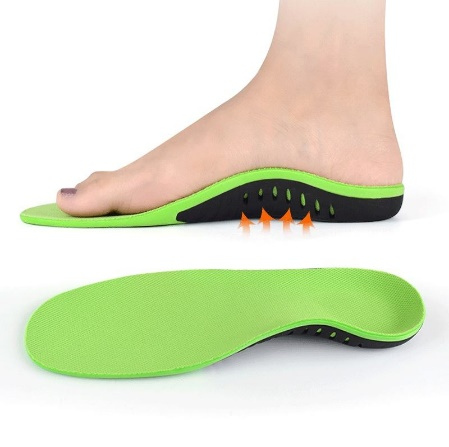What is an orthopedic insole:
Insoles are commonly used foot accessories  placed inside shoes, serving multiple purposes such as moisture absorption, anti-slip properties, cushioning and shock absorption, foot support, and enhancing foot function. , in addition to these basic functions, also correct and improve the distribution of foot pressure, conservatively treat certain foot ailments, improve the biomechanical characteristics of the lower limbs, prevent and treat some knee joint disorders, as well as adjust overall posture during standing and walking, thereby improving back and waist pain, among other functions.
placed inside shoes, serving multiple purposes such as moisture absorption, anti-slip properties, cushioning and shock absorption, foot support, and enhancing foot function. , in addition to these basic functions, also correct and improve the distribution of foot pressure, conservatively treat certain foot ailments, improve the biomechanical characteristics of the lower limbs, prevent and treat some knee joint disorders, as well as adjust overall posture during standing and walking, thereby improving back and waist pain, among other functions.
In clinical practice, custom- molded orthopedic insoles vary in cost and labor expenses, resulting in differences during use. Custom-molded orthopedic insoles truly achieve personalization but come at a high price.
Orthopedic insoles treat plantar fasciitis.
Recent studies have found that orthopedic insoles can effectively alleviate foot pain in patients with plantar fasciitis (PF) and improve foot function. Research indicates that orthopedic insoles alter the distribution of pressure on the foot, gradually correct abnormal biomechanical alignments, provide support to the arch, thereby relieving foot pain, and promoting the repair of the plantar fascia. Therefore, orthopedic insoles can be used to reduce foot pain and improve foot function in PF patients.
The application of orthopedic insoles in the rehabilitation of knee joint deformities.
Common knee joint deformities are categorized into genu varum (bowlegs) and genu valgus (knock-knees).
Genu varum, commonly known as “O-legs,” is characterized by ankle joints that point outward. Research comparing flat insoles to lateral wedge insoles has shown that long-term use of lateral wedge insoles can reduce ankle outward tilting and alleviate ankle joint instability.
Genu valgus, commonly known as “X-legs,” is characterized by knees that are closer together than the feet. Unlike genu varum, genu valgus involves greater stress on the lateral side, which can be mitigated by using wedged insoles that are thicker on the inside rear and thinner on the outside.
Orthopedic insoles are widely used in the rehabilitation of lumbar and back conditions.
In clinical studies, the manufacturing of orthopedic insoles for back pain patients differs from conventional methods. This corrective technique emphasizes adjusting the center position of the calcaneus during standing, ensuring the body’s center aligns accurately with the weight-bearing position, thereby restoring proper biomechanical posture.
The development of orthopedic insoles
Orthopedic insoles are more popular in European and American countries, while in China, they are still in the early stages of development. With widespread clinical application, orthopedic insoles have shown promising results in adjusting plantar pressure and lower limb alignment to improve treatment outcomes for various conditions. There is an increasing trend
Post time: Jun-19-2024





